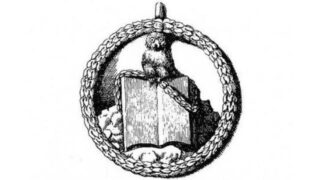After World War II, the order survived in Switzerland and remained in Outer Appenzell until 2008.
by Massimo Introvigne
Article 8 of 9. Read article 1, article 2, article 3, article 4, article 5, article 6, and article 7.


The slow international progress of the “second” Illuminati that we mentioned in the previous article was stopped by Nazism. In October 1932, the Illuminati elected Julius Meyer (†1955) as the successor of Leopold Engel, who had died in 1931, but in February of that year German voters gave a relative majority in their Parliament to the Nazis, who had in their program the dissolution of Freemasonry and all para-Masonic societies. Hitler became Chancellor of Germany on January 30, 1933; shortly thereafter, the German Illuminati prudently decided to suspend their activities, which were officially dissolved in 1934, with the Gestapo confiscating much of their documents. The imaginary darkness of Engels’ novels was being replaced by the real darkness of Nazi Germany.
German governmental decisions did not affect Illuminati outside Germany. In 1935, a new “areopagus” (which prudently avoided the Masonic name “lodge”) of the Illuminati was founded in Vienna, reserving membership to “Aryans” only and excluding Jews. The Swiss Illuminati, disciples of a Jew like Pinkus and mostly of Socialist and Communist ideas, immediately declared the Vienna group “irregular.” The problem was solved by Hitler’s Anschluss of Austria, in 1938, after which the activities of the Vienna areopagus ceased.
In the meantime, the Viennese had authorized a young Polish “fringe” Mason, Jan Korwin Czarnomski (1912–1944), to establish a branch of the World League of the Illuminati in Warsaw, which joined several other occult orders Czarnomski was promoting in Poland. Czarnomski was murdered in 1944. While pro-German anti-Masonic forces were blamed for the crime, and this remains a possibility, recent studies have suggested that there are other hypotheses as well, from robbery to jealousy to internecine struggles between esoteric groups.
Julius Meyer survived the war, and so did the Swiss Illuminati. Not all of the latter were prepared to acknowledge the leadership of the German lodges, as if the war had not happened. Meyer was still trying to reorganize the Illuminati as a viable international organization when he died in 1955.


With Meyer’s death, not much was left of the Illuminati in Germany, but there were still active members in Switzerland, where in 1943 a young man had been initiated that will keep alive the order for several decades, Hermann Joseph Metzger (1919–1990). Born on June 20, 1919, Metzger was a modest baker who, during the war years, had earned his living as an illusionist under the stage name of “Peter Mano” and as a graphologist. Like the richer circle of Swiss Illuminati gathered around economist Felix Lazerus Pinkus, Metzger was a Socialist. Pinkus took Metzger under his wing, and left to him his Psychosophical Society.
After the death of the legitimate “Guardian” of the Swiss Illuminati, Pinkus’ disciple Karl Brodbeck, in 1955, the surviving members appointed Metzger as “Guardian.” Gradually, Metzger turned the small Swiss village where he lived, Stein, in the Swiss canton Appenzell Ausserrhoden, into an esoteric center of some renown. Until the late 1960s, Metzger conducted his esoteric activities primarily on behalf of the Ordo Templi Orientis (claiming succession in a “pre-Crowleyan” branch independent from the organizations inspired by Aleister Crowley) and the Psychosophical Society rather than the Illuminati. However in 1965, Maximilian Haitz, to whom Meyer had left a power of attorney to continue the Illuminati, died, leaving his authority to Anita Elizabeth Borgert (1918–2015), who had the title of “Chancelor” of the German Illuminati, although the order was not really functioning.


Metzger was living in Stein in a de facto polygamy with three women. The first was his wife, Rosalie Strickler (1909–1972). The second was a Swiss member of the Illuminati, Annemarie Aeschbach (1926–2008). The third was Anita Elizabeth Borgert, who gave Metzger two children. Because of Borgert’s authority, Metzger started proclaiming himself the leader of the World League of the Illuminati. The title was not uncontested, as branches of the Ordo Templi Orientis and parallel organizations such as the Fraternitas Saturni were also conferring initiations in the Illuminati.


Metzger revived the Quibus licet, the notebook on which the leader of the Bavarian Illuminati, Weishaupt, made his disciples write down their spiritual experiences and the main activities carried out for the order. Metzger understood it as a magic diary, on which even the most secret thoughts and experiences should be transcribed and disclosed to the leader. Through this practice, he insisted, the Illuminati should learn to abandon themselves to the mystical current that pervaded the order.
This current, for those living in Stein, also had a natural manifestation. Borgert and then Aeschbach had the center in Stein recognized as a weather observation station by the Swiss authorities. If their notes on weather and rain were of some help to Bern’s statisticians and local farmers, for the Illuminati they also had an esoteric meaning, and measured the mysterious energy currents that they believed pervaded the area.
Metzger also reorganized Engel’s system, articulating it in thirteen degrees. The path should allow to reach the degree of illuminatus after having made the experience of other esoteric organizations: after a period of examination in an “outer circle” (I° degree), the adepts passed to the Gnostic Church (II°), to the three traditional Masonic degrees of apprentice, fellow, and master (III°, IV°, and V°), to the higher Masonic degrees (VI° and VII°) derived from the so-called “Egyptian rites” of Freemasonry, to the Fraternitas Rosicruciana Antiqua, one of the many competing Rosicrucian orders (VIII°), to the “mystical Freemasonry” (also derived from the “Egyptian rites”: IX° and X°), to the Ordo Templi Orientis (XI° and XII°) and finally to the real Illuminati (XIII°). As can be seen, by the time he or she reached the thirteenth degree of illuminatus, the member of the Illuminati had made a nice collection of initiations.
As for the “secret” of Metzger’s Illuminati, it was twofold. On the one hand, it was a perfect Masonic experience, which the Illuminati of Bavaria had transmitted, but not invented, as Metzger claimed it had an ancient origin. On the other hand, Metzger transmitted to the Illuminati notions of sexual magic derived from Reuss and other Ordo Templi Orientis sources.
Metzger also improved Engel’s legend of the Illuminati, claiming Wolfgang Amadeus Mozart (1756–1791), Goethe (who, as mentioned in a previous article, had a short-lived affiliation with the Illuminati of Bavaria), and the famous Swiss pedagogist Johann Heinrich Pestalozzi (1746–1827) as past Grand Masters. He supported these claims with “historical” documents of questionable authenticity. When the documents were exposed as forgeries, the few members Metzger and Borgert had recruited in Germany left and founded a schismatic Ordo Illuminatorum.
Worse was to come. Metzger’s organization became noticeable enough to attract the attention of the anti-cult movement. Lutheran pastor Friedrich-Wilhelm Haack (1935–1991), the “patriarch” of the German anti-cult movement, and tabloid journalist Horst Knaut went on a rampage against Stein’s “Satanists.” Knaut lost a libel suit in 1975, but continued to attack Metzger, claiming (falsely, although the Illuminati did teach sex magic) that “Satanic orgies and Black Masses” were organized in Stein. This scared a few members, including Borgert, who in 1975 left Stein with her and Metzger’s two sons, Parcival Peter (1951–1994) and Simon Magus (1952–1998). Metzger was hit by the separation and the media slander. His later years were marked by increasing problems of alcoholism. He died on June 14, 1990.


In its heydays, the Illuminati in Stein had operated a hotel, the Gasthof Rose, a large esoteric library, a museum, international conferences and esoteric film festivals. One after the other, these activities were discontinued, although a handful of Illuminati continued to live in Stein around Annemarie Aeschbach. She died in 2008 and the Stein Illuminati disbanded, leaving their considerable library and archives to the Cantonal Library of Appenzell Ausserrhoden. In 2017–18, part of this collection was exhibited by the Appenzeller Volkskunde-Museum Stein. The exhibition, “Do What Thou Wilt—The Search for Meaning in Stein,” attracted international visitors. It also certified that the “second” Illuminati, just like the first, were now extinct. But their myth lived on.









